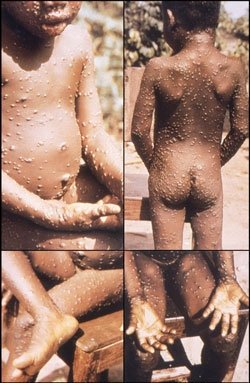05.07.2022
Information about monkeypox has shaken the whole world. According to the WHO, monkeypox is a disease of global public health importance, as it affects not only West and Central Africa but also the rest of the world.
In May 2022, numerous cases of monkeypox were detected in several non-endemic countries. Research is currently underway to better understand the epidemiology, sources of infection, and transmission patterns. This article summarizes what is currently known.
Monkeypox (variola vimus) - (variola virus) is a rare zoonotic disease (i.e. transmitted to humans from animals) caused by the monkeypox virus.
The causative agent of monkeypox is classified as a biological agent, which is officially recognized as a biological weapon.
Symptoms of this disease in humans are similar to those observed in the past in patients with smallpox (which was completely eliminated worldwide in 1980 by vaccination).
Monkeypox was first discovered in 1958, when two outbreaks of a smallpox-like disease occurred in monkey colonies kept for research, hence the name "monkeypox".
The first case of monkeypox in humans was reported in 1970 in the Democratic Republic of Congo during a period of intense smallpox eradication efforts. Since then, human monkeypox has been reported in other countries in Central and West Africa. Cases of monkeypox in humans outside Africa (including in the United States, Israel, and the United Kingdom) are believed to be associated with international travel and animal imports.
The natural reservoir of monkeypox remains unknown. However, African rodents and primates (e.g. monkeys) can carry the virus and infect humans.
In humans, symptoms of monkeypox are similar to those of smallpox but less severe. The incubation period (time from infection to onset of symptoms) for monkeypox is usually 7-14 days but can range from 5-21 days.
The onset of the disease:

Within 1-3 days (sometimes longer) after the onset of fever, the patient develops a rash, which often starts on the face and then spreads to other parts of the body.
The skin lesions progress through the following stages: macules → papules → vesicles → pustules → scabs, which eventually fall off.
Monkeypox is usually a disease that goes away on its own, with symptoms lasting from 2 to 4 weeks. Although there are severe cases. Recently, the mortality rate is about 3-6%.
A distinctive feature of monkeypox from smallpox is lymphadenopathy (enlarged lymph nodes). Usually, this occurs with the onset of fever, 1-2 days before the rash or (rarely) simultaneously with the rash. Lymph nodes may swell in the neck (submandibular and cervical), axillary, or groin areas and appear unilaterally or bilaterally.
Transmission of the monkeypox virus occurs when a person comes into contact with the virus from an animal, person, or material infected with the virus. The virus enters the body through damaged skin, respiratory tract, or mucous membranes (eyes, nose, or mouth). Animal-to-human transmission can occur through bites or scratches, cooking meat from wild African animals, direct contact with body fluids or rashes, or indirect contact with material such as contaminated bedding.
Human-to-human transmission is thought to occur mainly by airborne droplets, namely through large respiratory droplets (which do not spread over long distances, so close face-to-face contact is required for infection). Other ways of transmission from person to person include direct contact with body fluids or rash elements, as well as indirect contact with rash elements, for example through contaminated clothing or underwear.
Preventive measures to prevent infection with the monkeypox virus:
There is currently no proven, safe treatment for monkeypox. Smallpox vaccines, antiviral agents, and cowpox immunoglobulin (VIG) are used to control the outbreak of monkeypox.
Media reports, that Belgium has become the first country to introduce a mandatory 21-day quarantine for people infected with the monkeypox virus, as 14 countries now confirm outbreaks of the viral disease.
(с) 2024